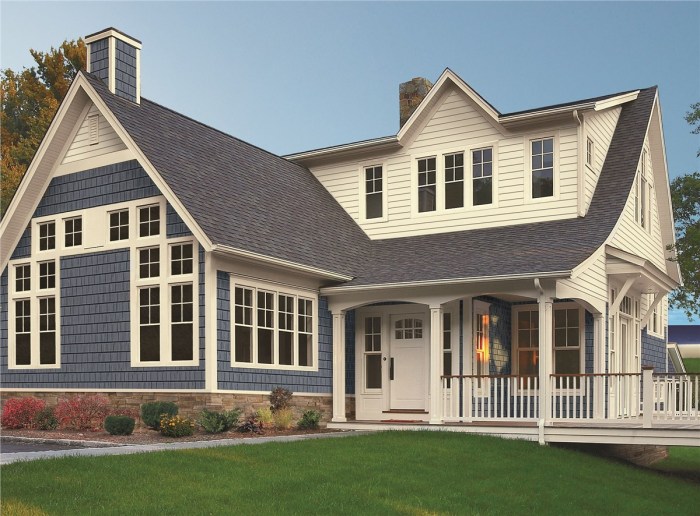Long-lasting Insulated Siding: Thinking about upgrading your home’s exterior? Forget flimsy siding that needs constant repairs! This deep dive explores the world of long-lasting insulated siding, from choosing the perfect material to mastering the installation and ensuring years of worry-free beauty and energy savings. We’ll uncover the secrets to selecting the right siding for your budget and style, covering everything from vinyl’s practicality to the elegant appeal of fiber cement.
Get ready to transform your home’s exterior and boost its value – all while enjoying lasting peace of mind.
We’ll cover the different materials available, their pros and cons, installation techniques, maintenance tips, and even the environmental impact. We’ll also delve into the long-term cost-effectiveness, comparing initial investments with the significant energy savings you’ll reap over the years. By the end, you’ll be armed with the knowledge to make an informed decision that will enhance your home’s aesthetic appeal and significantly increase its value.
Array
Choosing the right insulated siding isn’t just about durability; it’s a crucial design decision that significantly impacts your home’s curb appeal and overall aesthetic. The right siding can dramatically enhance your home’s value and make a lasting impression. Let’s explore the visual possibilities.
Siding Styles, Colors, and Textures, Long-lasting Insulated Siding
Long-lasting insulated siding offers a surprisingly diverse range of styles, colors, and textures to suit any architectural style and personal preference. From classic to contemporary, the options are virtually limitless, allowing homeowners to express their unique tastes and enhance their property’s visual appeal. Manufacturers offer a wide spectrum of colors, from subtle neutrals to bold, vibrant hues, ensuring a perfect match for any home and landscape.
Furthermore, textures range from smooth and sleek to deeply embossed, mimicking the look of natural materials like wood or stone. This variety ensures homeowners can find the perfect balance of style, durability, and aesthetic appeal.
Examples of Siding Choices Enhancing Curb Appeal
The right siding choice can transform a home’s exterior. Consider these examples:
- Classic White Vinyl Siding with Subtle Texture: This timeless choice provides a clean, crisp look that complements almost any architectural style. The subtle texture adds depth and visual interest without being overpowering, creating a welcoming and sophisticated aesthetic. It’s a popular choice for its low maintenance and ability to brighten up a home’s exterior.
- Dark Gray Fiber Cement Siding with a Wood-Grain Texture: This option provides a modern, sophisticated look. The dark gray color offers a striking contrast against lighter colored trim and landscaping, while the wood-grain texture adds warmth and visual interest. This combination is perfect for homes with a contemporary or craftsman-style design.
- Warm Beige Engineered Wood Siding with a Smooth Finish: This siding offers a more natural and rustic look, ideal for homes nestled in a landscape with abundant greenery. The warm beige complements natural surroundings and creates a harmonious blend of architecture and nature. The smooth finish contributes to a clean, sophisticated appearance.
Choosing Siding to Complement Architectural Styles and Landscaping
The key to successful siding selection lies in considering the existing architectural style and landscaping. For example, a Victorian home might benefit from intricately detailed vinyl siding that mimics the look of wood shingles, while a modern farmhouse might be better suited to sleek, horizontal fiber cement planks in a muted color palette. Similarly, the landscaping should influence the color choice.
Homes surrounded by lush greenery might look stunning with earth-toned siding, while those with more arid landscapes might benefit from lighter colors to reflect sunlight and prevent overheating.
Visual Representation of a Home with Long-lasting Insulated Siding
Imagine a charming two-story craftsman-style home. The siding is a rich, deep brown engineered wood siding with a subtle vertical grain texture. The trim is painted a crisp white, creating a beautiful contrast. The windows are framed with white, adding to the clean lines. The roof is a dark gray asphalt shingle, complementing the siding and adding a touch of sophistication.
The landscaping includes a neatly manicured lawn, flowering bushes, and mature trees, all harmonizing with the warm tones of the siding and creating a welcoming and visually appealing home. The overall effect is a classic, timeless aesthetic that blends seamlessly with its surroundings.
Ultimately, investing in long-lasting insulated siding is an investment in your home’s future. From enhancing curb appeal to bolstering energy efficiency and minimizing maintenance headaches, the benefits are undeniable. By carefully considering the various materials, installation methods, and long-term costs, you can transform your home’s exterior while maximizing your return on investment. So, ditch the worries of frequent repairs and embrace the enduring beauty and performance of long-lasting insulated siding – your home will thank you for it!
Top FAQs: Long-lasting Insulated Siding
What’s the average lifespan of insulated siding?
The lifespan varies depending on the material and maintenance, but many options last 30-50 years or more.
Can I install insulated siding myself?
While possible for some DIYers, professional installation is often recommended for optimal results and warranty coverage.
How often should I clean my insulated siding?
A yearly cleaning with a gentle detergent and water is generally sufficient, but more frequent cleaning may be needed depending on your climate and environment.
Does insulated siding increase my home’s value?
Yes, significantly. Energy-efficient upgrades like insulated siding are highly desirable and can boost your home’s resale value.
What are some common signs that my insulated siding needs repair?
Look for cracks, dents, loose panels, water damage, or significant discoloration. Address minor issues promptly to prevent larger problems.



